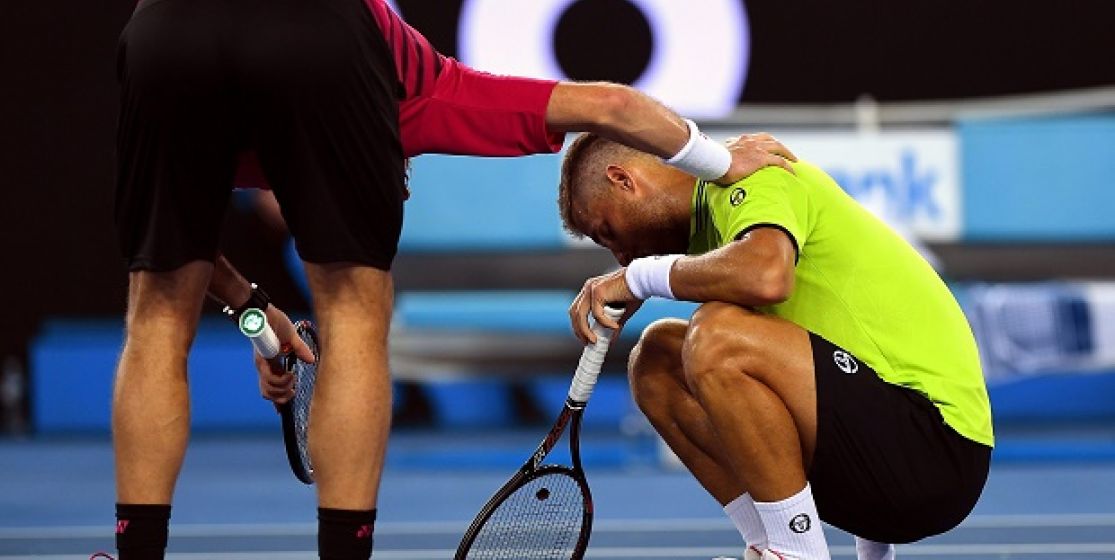At the start of last week, Wawrinka got noticed for hitting a ball which ended in Klizan’s private parts. Which the Slovakian didn’t enjoy at all. So, should we consider this type of shot like a lack of respect ? And which consequences can it have ?
On the court, Stan Wawrinka is gritting his teeth. Seeded at the fourth spot, the Swiss is having a hard time in the first round of the Australian Open against Martin Klizan, the world number 34. Who’s leading 30-15, 4-4 on his opponent’s serve in the fifth set. If the winner of the last US Open drops his serve, he’ll concede a break point, potentially leading to a score of 5-4 in his opponent’s favor. So Wawrinka decides to play at full speed. On one of Klizan’s missed drop shots, the favorite hits a missile…directly into the Slovakian’s testicles, while the rest of the court is completely opened. The Slovakian immediately screams from the pain, despite Wawrinka’s apologies. And ends up losing the set (6-4) before losing the match.
So, is this not-so-rare shot intentional ? « Of course, says Thomas Giraud, a member of the Soyez P.R.O team, a mental coaching method imagined by Ronan Lafaix, who works with Gilles Simon and Stéphane Robert. But let’s be clear : his intention is not to hurt his opponent, but to win the point. First because it’s not Stan’s typical attitude, as he’s not considered to be one of the bad boy of the circuit. And then, because he wants to win, and the best possible shot at that moment of the match is aiming at the player. » Aiming the ball at your opponent could be an option among many others, which shouldn’t be considered as a lack of respect. It should even be considered as a weapon which should be used when the situation requires it, according to Thomas Giraud : « Coaches have no qualms when it comes to recommending this shot to their players. If it enables you to win the point, you have to do it. The idea is to find the zone which gives you the most chances of unsettling your opponent. » Therefore, aiming at Klizan seemed to be the best decision at that moment. Especially in this situation : « When you’re a little nervous at 4-4, in a tight match, you don’t necessarily want to take the risk of aiming at the lines. »
« He made the mistake of completely stopping »
« I had stopped playing. He could have aimed anywhere else. », Klizan still complained, looking furious in the post-match press conference. Although the lefty, who remains an unpredictable and creative player capable of hitting surprising shots, could have faked abandoning the point before getting back at it, in order to take Wawrinka by surprise. Something which the Swiss said after the match : « It was a very important point. There have often been examples of playing who pretend to stop playing, and all of a sudden start again. I’ve already fell for the trick. I’ve already missed easy shots like this one. There, I didn’t question myself. I didn’t want to take any risks. And he took the shot in a delicate part…Thankfully, he was fine. It’s true, it’s rare to see a player hit so hard towards his opponent. But he made the mistake of completely stopping. » A player giving up, the other sending a message of domination : there is also a psychological factor in this type of shot. « Wawrinka’s shot, hit like a warrior, clearly means : « I’m not here to be nice. If you’re on my way, tough luck », says Thomas Giraud.
For the victime, this shot can be taken for an humiliation and generate anger. But the culprit can also feel shame. In both cases, the most important thing is to handle the situation. The mental trainer gives his own point of view : « It’s not so easy for Wawrinka. In his position, some players feel uncomfortable, and can be unsettled. There, Stan reacted in the best of ways : he crossed the net and apologized. He’s right, because if he hadn’t done that, the crowd could have booed him. And moreover, he managed to get over the incident. He checked on Klizan and that was it, the incident was over. » Which wasn’t the case for Klizan. « When you get hit by a ball, you often feel anger at first. And after that, there is generally a bit of resentment, with negative thoughts leading to you using too much unnecessary energy. You’re still focused on the past. At this key-moment of the match, the energy should only be dedicated to the game. » This analysis was confirmed by the player’s reaction in the press conference, as he analyzed the incident from an emotional point of view - « It wasn’t an accident » - before becoming more rational - « If it interfered with my focus afterwards ? No. I don’t want to comment. I don’t care. » The proof that even after the match, nothing is forgotten. And that Wawrinka’s victory can partly be explained by this shot, which was theoretically insignificant.






